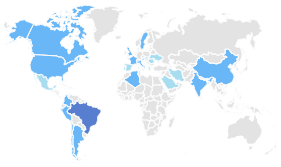Solar Thermo-Powered Desalination Fountain-Barge: A Macro-Imagineering NA Venezuela’s Golfo de Cariaco (Fonte-Barcaça de Dessalinização Termo-Alimentada por Energia Solar: Uma Macro-Imagenharia NA, Golfo de Cariaco, Venezuela)
Resumo
Based mainly on the Fourier Law valid for parallel material layer temperature gradients, a massive floating seawater desalination macro-project almost entirely covering the Golfo de Cariaco, NE Venezuela, is proposed. The purpose of the geographically-scalable unsinkable Fountain-Barge Desalination Factory (FBDF) formed chiefly of composite metal foam is bulk freshwater production then to be utilized domestically for commercial crop irrigation and urban population maintenance and increase. Brine reject from the huge FBDF could allow 21st Century development of a commercial aquaculture industry during a potential local encompassing region BSw Koppen Climatic Classification change as well as adjacent southern Caribbean Sea changes [1].
Key words: Freshwater production, aquaculture industry, solar thermal-powered desalination fountain-barge.
===========================================================================
Com fundamento na Lei de Fourier, válida para gradientes de temperatura em camadas paralelas de material, propõe-se um macroprojeto flutuante de dessalinização da água do mar cobrindo quase inteiramente o Golfo de Cariaco, NE Venezuela. O objetivo da Fountain-Barge Desalination Factory (FBDF), geograficamente escalável e formada principalmente de espuma de metal compósito, é a produção de água doce para ser utilizada em residências, em irrigação comercial e demais aplicações da população urbana. A rejeição de salmoura da grande FBDF poderia permitir o desenvolvimento, no século XXI, de uma indústria de aquacultura coetânea à potencial transformação da região de BSw Koppen, assim como às mudanças adjacentes no sul do Caribe [1].
Palavras-chave: Dessalinização da água do mar, indústria de aquacultura, barcaça-fonte termosolar.
Texto completo:
PDFReferências
Rozwadowski, H. (2018) Vast Expanses: A History of the Oceans. Reaktion Books, London, England. 272 pages.
Dobraszczyk, P. (2019) Future Cities: Architecture and the Imagination. Reaktion Books, London, England. 272 pages.
Juuti, P.S. et al. (2015) “Short History of Fountains” Water 7: 2314-2348.
Campra, P. et al. (2013) “Mesoscale Climatic Simulation of Surface Air Temperature by Highly Reflective Greenhouses in S.E. Spain” Environmental Science & Technology 47: 12284.
Gabbrielli, E. (2013) “Early history of desalination in Latin America”. International Desalination Association Journal of Desalination and Water Reuse 5: 96.
Tellman, B. et al. (2018) “Opportunities for natural infrastructure to improve urban water security in Latin America”. PLoS ONE 13: e0209470.
Glater, J. (20 September 1998) “The early history of reverse osmosis membrane development” Desalination 117: 297-309.
Delgado-Torres, A.M et al. (2019) “Chapter 3-Water Desalination by Solar-Powered RO Systems”, pages 45-84 IN Current Trends and Future Developments on (Bio-)Membranes: Renewable Energy Integrated with Membrane Operations.
Stuyfzand, P.J. and Kappelhof, J.W.N.M. (2005) “Floating high-capacity desalting islands on renewable multi-energy supply” Desalination 177: 259-266.
Silver, R.S. (1988) “Desalination—The Distant Future”. Desalination 68: 1.
Kaya, H. (1991) “Ideal grand design for enclosed coastal areas”. Marine Pollution Bulletin 23: 463-467.
Rutkow, E. (2019) The Longest Line on the Map: The United States, the Pan-American Highway, and the Quest to Link the Americas. Scribners, New York. 448 pages.
Van Daele, M. et al. (2011) “Reconstruction of Late-Quaternary sea- and lake-level changes in a tectonically active marginal basin using seismic stratigraphy: The Gulf of Cariaco, NE Venezuela”. Marine Geology 279: 37-51.
Glade, H.G. (1961) “Further hydrographic observations in the gulf of Cariaco, Venezuela. The circulation and water exchange”. Boletin de Instituto Oceanographico. Venezuela 1: 359-395.
Richards, F.A. (1975) “The Cariaco Basin (Trench)”. Oceanography Marine Biology Annual Review 13: 11-67.
Riboulleau, A. et al. (2014) “Controls on detrital sedimentation in the Cariaco Basin during the last climatic cycle: insight from clay minerals”. Quaternary Science Reviews 94: 62-73.
Laval, B.E. et al. (2005) “Dynamics of a large tropical lake: Lake Maracaibo”. Aquatic Sciences 67: 337-349.
Olivo, M. de Lourdes (29 December 1997) “Assessment of the vulnerability of Venezuela to sea-level rise”. Climate Research 9: 57-65. SEE also: Volante, C.R. and Arismendi, J. (Spring 1995) “Sea-Level Rise and Venezuela: Potential Impacts and Responses”. Journal of Coastal Research Special Issue 14. Pages 285-302.
Herrera, D.A. et al. (2018) “Exacerbation of the 2013-2016 Pan-Caribbean Drought by Anthropogenic Warming”. Geophysical Research Letters 45: 10619-10626.
Taylor, G.T. et al. (20 November 2012) “Ecosystem responses in the southern Caribbean Sea to global climate change”. Proceedings of the National Academies of Science (USA) 109: 19315-19320.
O’Loughlin, K.F. and Lander, J.F. (2003) Caribbean Tsunamis: A 500-year History from 1498-1998. Kluwer Academic Publishers, Boston, USA. 263 pages.
Audemard, F.A. and Guzman, A.F.L. (2017) “Reliability of first-hand accounts on the study of historical tsunamis in northeastern Venezuela (southeastern Caribbean Sea)”. Annals of Geophysics 60: S0660.
Aguilar, I. et al. (March 2017) “Calculation of the reservoir age from organic and carbonate fractions of sediments in the Gulf of Cariaco (Caribbean Sea)”. Quaternary Geochronology 38: 50-60.
Busey, H.M. (1969) “Floating Plants for Seismic Protection” Nuclear Applications 6: 533-543.
Wang, C.M. et al. (May 2010) “Literature Review of Methods for Mitigating Hydroelastic Response of VLFS Under Wave Action”. ASME Applied Mechanics Review 63: 1-18.
Cathcart, R.B., Bolonkin, A.A., Badescu, V. and Stanciu, D. (2013) “Shaped Metal Earth-Delivery System”, page 421 IN Badescu, V. (Ed.) Asteroids: Prospective Energy and Material Resources. Dordrecht: Springer. 689 pages.
Marx, J. and Rabiei, A. (November 2017) “Overview of Composite Metal Foams and Their Properties and Performance”. Advanced Engineering Materials 19: 1600776.
Grabian J. et al. (15 December 2017) “The role of innovative composite materials in the safe and efficient operation of floating marine structures”. Scientific Journals of the Maritime University of Szczecin (Poland) 52: 23-29.
Cooper, T.A. et al. (2018) “Contactless steam generation and superheating under one sun illumination”. Nature Communications 9: 5086.
Ni, G. et al. (14 March 2018) “A salt-rejecting floating solar still for low-cost desalination”. Energy & Environmental Science 11: 1510-1519.
Michael, M. (7 May 2018) “On ‘Aesthetic Publics’: The Case of VANTAblack”. Science, Technology & Human Values 43: 1098--1121 .
Yilmaz. A. (2016) “Color of absence and presence: Reconsidering black in architecture”. Color Research & Application 42: 378-387.
Giwa, A. et al. (2017) “Brine management methods: Recent innovations and current status”. Desalination 407: 1-23.
Lemus, Jesus (2014) “Analisis especial para el ordenamiento de la zona costera del Golfo de Cariaco, estado Sucre, Venezuela”. Terra Nueva Etapa XXX, 47: 33-53.
DOI: http://dx.doi.org/10.17648/calibre.v3i3.447
Apontamentos
- Não há apontamentos.
Direitos autorais 2019 Richard Brook Serpa
Indexadores, Diretórios, Bases de Dados e Registros (Abstracted and Indexed in):

CALIBRE - Revista Brasiliense de Engenharia e Física Aplicada
ISSN Eletrônico: 2526-4192































